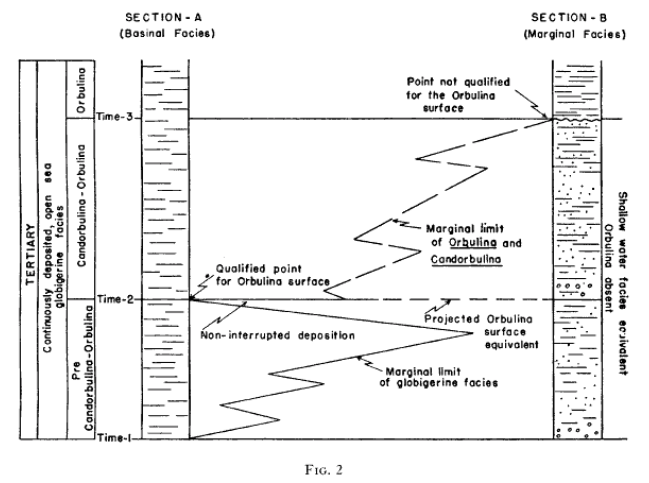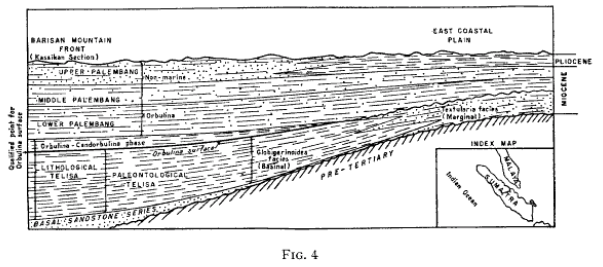The Orbulina datum is now a well known evolutionary datum in foraminiferal biostratigraphy that approximates the base of the Middle Miocene. Not many people will know that this early step in proposing planktonic foraminifera as time-correlatable events was based on work in Sumatra, by LeRoy, in 1948. For those not familiar with it, Orbulina is a very distinct, spherical planktonic foraminifera about 500 microns in diameter. It contains a juvenile stage of the ancestral Globigerinoides form within this sphere.
At the time of his paper LeRoy noted that: “A survey of the contributions shows that little attention has been given to the possible correlative time value of the less diversified pelagic Foraminifera. It is the writer’s conviction that this group of fossils holds the solution for imporving and establishing more accurate long range Tertiary correlations.” That is, until then, the primary foraminifera used in SE Asia where LeRoy did his pioneering work were the benthic larger foraminifera which defined the Letter Stages (replacements for the European Epochs, such as Eocene, Oligocene and Miocene which could not be defined in SE Asia)
SE Asia used to make major contributions to stratigraphy and thereby sedimentary and general geology. There has been a pause in such contributions, but this site aims to rectify this.


A key part of defining the Orbulina datum was to note that it was part of an evolutionary succession; Globigerinoides to “Candorbulina” (now called Praeorbulina) then Orbulina universa. In Sumatra some areas on the basin margin had limited planktonic faunas and the lowest record of Orbulina was not at the evolution datum but the base of a transgressive succession. Thus the presence of the ancestral forms developing into the descendant was validation of the true Orbulina datum.

The conclusion of LeRoy’s paper stated that:
1. It is confidently predicted that the much neglected pelagic Foraminifera, when systematically studied, will be found to possess greater value for both regional and provincial Tertiary time-stratigraphic correlation than do the benthonic Foraminifera.
2. The writer is convinced that with adequate and proper stratigraphical and faunal control, Orbulina universa and Candorbulina universa will permit definition of a time horizon (Orbulina surface) within Middle Tertiary sequences throughout tropic and subtropic regions.”
The Orbulina datum was soon found to be a practical datum in many tropical and sub-tropical open marine facies. Other planktonic foraminifera datums began to be recognised in order relative to this near base Middle Miocene reference level, and planktonic biostratigraphy began to rapidly develop as a major advance in Cenozoic and then Mesozoic stratigraphy.
LeRoy, L. W., 1948. The Foraminifer Orbulina universa d’Orbigny, a suggested Middle Tertiary time indicator. Journal of Paleontology 22, 500-508
Be First to Comment